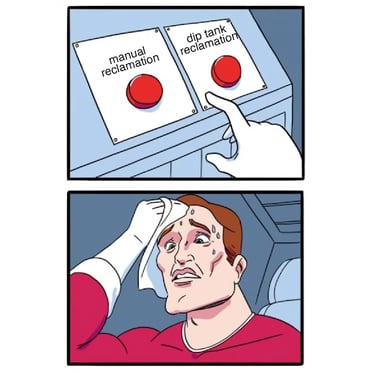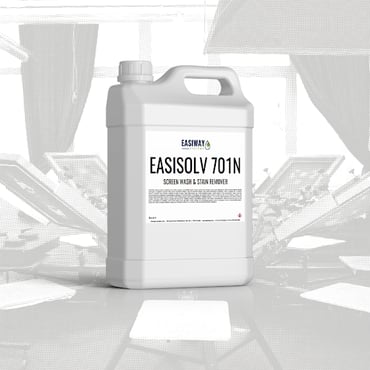Keep Calm and Reclaim On: Your Guide To Reclaiming Screens With Ease

If you’re a screen printer, chances are the words “reclaiming screens” don’t exactly spark joy. We get it — scraping gunk and scrubbing screens ranks right up there with a root canal on the fun scale.
 But while reclaiming might not be the most glamorous part of printing, it is a crucial piece of the puzzle. Taking the time to properly reclaim your screens saves major time, money, and frustration compared to janky, half-hearted cleaning.
But while reclaiming might not be the most glamorous part of printing, it is a crucial piece of the puzzle. Taking the time to properly reclaim your screens saves major time, money, and frustration compared to janky, half-hearted cleaning.
The good news? We've put together the ultimate guide to make reclaiming screens as quick and painless as possible. No more wrestling with dried ink and emulsion.
Ready to transform reclaiming from dreadful to effortless? Let’s do this.
CHOOSE YOUR RECLAIM ADVENTURE: MANUAL VS. DIP TANK
When it comes to reclaiming screens, you've got options. Let's compare the key steps for old-school manual reclamation versus modern dip tank cleaning.
FIRST THINGS FIRST: DRESS FOR THE JOB
Before diving into the reclaim process, take a minute to gear up! Chemical safety data sheets outline the minimum protective equipment for working with cleaners and solvents. Often, that means donning rubber gloves and safety glasses.
MANUAL RECLAMATION
For those who prefer hands-on cleaning, grab your spray bottles and get scrubbing:
- Card off the excess ink and peel away any tape. Leaving tape behind creates a sticky, gummed-up mess.
- Give both sides a good spray and scrub down with a screen wash like Easiway's EasiSolv 701. This removes stubborn ink residue.
- Starting from the bottom, blast the ink side with a high-pressure rinse. Letting the water work upwards gives the chemicals extra time to penetrate and lift ink.
- Apply an emulsion remover, let it soak for 30 seconds, then rinse away. Allowing it to dwell liquefies the emulsion for easy removal.
- Hit both sides with a stain and haze remover. Scrub and rinse to remove ghost images and haze.
- Finish up with a light flood rinse to wash away any last traces of contaminants. Your screen will be sparkling clean!
DIP TANK RECLAMATION
A dip tank simplifies reclamation by automating some of the tough work:
- As before, card off excess ink and remove tape first.
- Submerge the screen in your dip tank solution for 1-2 minutes. Let the chemicals break down ink and emulsion.
- Pull out the screen and bring it to your washout booth.
- Blast both sides with a high-pressure rinse to wash away any loosened ink and emulsion.
- Apply stain and haze remover, scrub, and rinse to remove any lingering ghost images.
- Finish up with a thorough flood rinse to complete the cleaning process.
THE CHOICE IS YOURS!
Either reclamation method works great if done properly. Manual cleaning gives you more control over the process. Dip tanks automate much of the grunt work. Choose the option that best fits your workflow and budget. The important thing is that your screens get squeaky clean and reclaimed with care.
BATTLING STUBBORN STAINS?
Like death and taxes, some amount of staining is inevitable when it comes to reclaiming screens. No matter how hard you scrub or power wash, you'll eventually encounter ghost images and stubborn ink stains lurking in your mesh.
Before you toss in the reclaiming towel, know there are a few common culprits to blame for excess staining:
- Cranking up the squeegee pressure buries ink deeper into the knuckles of the mesh where it holds on for dear life. Ease up on the death grip for cleaner screens.
- Underexposed screens are stain magnets — the lack of hard emulsion lets ink pigments wander into the recesses of the mesh and take up permanent residence.
- Letting ink dry and sit on screens between jobs is asking for staining trouble. Reclaim ASAP before the ink dries into a stubborn mess.
- Short-run jobs create less staining than marathon 5,000+ piece runs that force ink to seep deep into the screen. More prints = more stain potential.
The good news? There are specialty screen wash products designed to tackle even the toughest stains without damaging the screen. We’ll talk more about that later.
Avoid these common reclaiming mistakes
Reclaiming screens is a breeze when you avoid the common mistakes. Steer clear of these goofs and save yourself a major headache down the road:
ALWAYS FINISH WITH A FLOOD RINSE
Don't skip this key step of a final gentle spray to remove any leftover gunk. Forgetting it leaves chemicals behind and makes a mess of things later. Give your screens some TLC with a thorough flood rinse when you're done.
TRAIN NEWBIES THOROUGHLY
Take time to walk new staffers through proper reclaiming techniques so they get off on the right foot. Proper training means less frustration (for them and you!). 
READ INSTRUCTIONS FULLY
We know reading manuals is oh-so-exciting. But take a few minutes to go over directions before trying new products. Those minutes could save hours of headaches later.
BUY QUALITY SUPPLIES
Resist the urge to cut corners with bargain bin tapes or chemicals you'll just fight to remove later. Quality supplies make reclaiming easier. Cheap ones create more work.
RECLAIM ASAP
Leaving ink to dry on screens between print jobs? Rookie mistake. Hop to it and reclaim quickly for easier cleaning. The longer the ink dries, the harder it'll be to remove.
Choosing the right reclaiming chemicals
Choosing the right reclaiming chemicals is crucial for effective screen reclamation. The ideal cleaners can power through ink, emulsion, stains, and more in one swipe.
At Easiway, our versatile 701 Screen Wash tackles it all — from stubborn ink to ghost images — leaving screens pristine.
For recommendations on dip tanks and other reclaiming gear that pairs perfectly with our cleaners, our team is here. We love helping customers find the ideal solutions for smooth, sparkling screen reclamation every time.
With the right chemicals and equipment, reclaiming screens becomes quick, easy, and efficient.